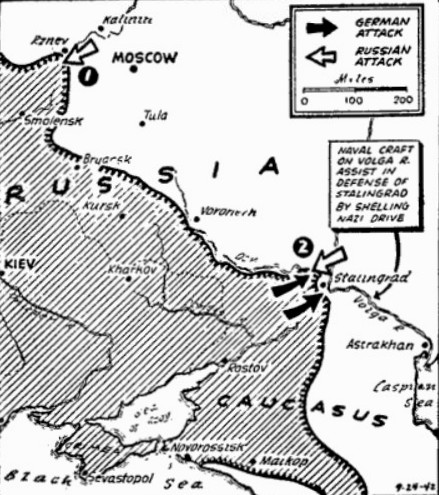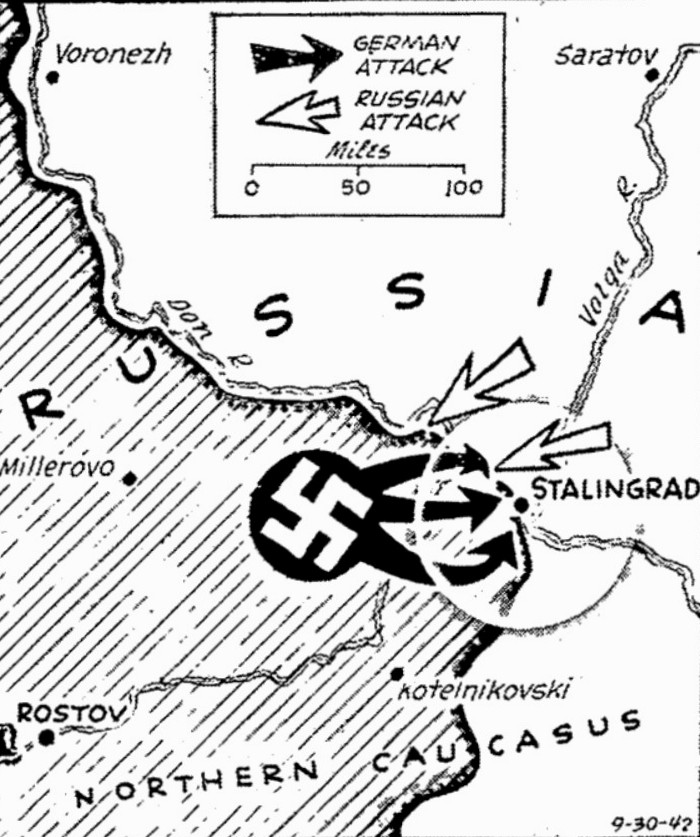The Pittsburgh Press (September 24, 1942)
Russians break through German lines in counterdrive outside Stalingrad
Reds repulse 12 attacks by 200 Nazi tanks in Volga city; stiff resistance upsets Axis plans in Caucasus Mountains
By Henry Shapiro, United Press staff writer
Russian picture brightens despite intensified German assaults on many parts of Stalingrad as the Red Army pushes its drive 110 miles from Moscow by bypassing Rzhev (1) and the Russians break through German lines northwest of Stalingrad (2). Moscow reported that the Axis drive in the Caucasus was delayed and may be halted completely.
Moscow, USSR –
The Red Army, rolling forward in a powerful counteroffensive northwest of Stalingrad, broke through the first German defense line today, according to front dispatches.
While Stalingrad suffered unprecedented devastation, Russian forces “somewhere to the northwest” were flinging the enemy back with infantry, artillery and aircraft. The latest Soviet communiqué said the Russians had driven the Germans from an occupied locality.
A dispatch from the North Caucasus Front meanwhile asserted that the Germans had been compelled by Red Army pressure to discontinue their offensive in mountain regions and to abandon several occupied positions, and that their plans to achieve a decision there before winter had been frustrated.
It was revealed today that a supreme bid by 200 German tanks to smash into the center of Stalingrad had been broken. The Germans lost 42 tanks in 12 consecutive attacks.
Bury tanks in streets
The tanks rumbled forward until special Russian detachments hurling hand grenades and benzine bottles and shooting anti-tank guns, halted them, and thrust back the 11 assaults that followed.
Then the Germans sent Tommy-gunners around the Russian flanks. The Germans seized part of a big building, and the Russians, unable to drive them out, sent five men forward, each carrying 55 pounds of high explosive.
They placed it at the walls. When it was exploded, the building collapsed then buried the Germans. They tried to advance in another part of the city, but lost two battalions (about 1,000 men), after which they buried their tanks and mine-throwers in the streets and used them as fixed artillery.
Volga fleet shells Nazis
Nevertheless, the Russians reported no new German advance in the Stalingrad area.
Soviet warships on the Volga River hurled shells into enemy possessions and concentrations, killing 1,000 Axis troops, and front dispatches said reinforcements and munitions were being rushed across by ferry and other craft.
Dispatches said the few women and children who remained in Stalingrad were living in cellars or in caves dug into the sides of ravines high on the Volga banks.
Bombs were raining on the river banks, it was said, raising great geysers of water and patting the shores.
Charred bodies of women and children killed when German planes smashed a ferry boat on the Stalingrad bank could be seen floating down river, it was said, among the bodies of dead soldiers.
Dispatches described a double battle in which the Red Army stabbed through the German first defense line northwest of the city and continued an advance in several sectors behind an airplane and artillery bombardment, with tanks and infantry following close behind the barrage.
Red Star described the German counterattacks toward the center of Stalingrad as the most powerful in a week.
A correspondent of Red Star, the Soviet Army organ, said that despite a ferocious and continuous air assault, the Russians were bringing up supplies and reinforcements and taking the wounded back across the Volga.
The correspondent wrote that Stalingrad’s horizon was covered with a great glare, the city was burning… “Tongues of flame are dancing and ashes flying.” Several streets had already disappeared, he wrote, and the debris of shattered German bombers littered those streets that remained.
The communiqué said the Germans had lost so heavily they were forced to rush up more reinforcements by air. It was the 31st day of the battle.
The frontlines were so close that all enemy movements could be seen from observation posts within the city without binoculars, dispatches said.
White chalk powder from the crumbling walls covered the faces of officers reporting to Russian headquarters in a deep cellar. The jagged walls of blasted buildings resembled medieval fortresses when shells and bombs burst, illuminating the landscape after nightfall.
Russian reports said that the Germans had lost more than 5,000 men, 109 tanks and 31 cannon in the past three days. The devastating character of close-quarter fighting was reflected in reports that the Germans had lost 118 machine-gun nests destroyed or captured in the same time.
Fighting was fierce and stubborn in the counteroffensive and the Russians faced the handicap of German air superiority. Artillery, firing point blank at a tactically important hill, however, had enabled the Russians to advance at one point.
Soviet Marines attack
Then outnumbered Soviet fighter pilots kept the German bombers at bay, while the Russians consolidated their new positions.
Four hundred Soviet Marines northwest of Stalingrad routed 1,000 Romanians and killed 900 of them.
The communiqué said the Germans concentrated their forces southeast of Novorossiysk, the Black Sea naval base they won 10 days ago, and attacked, but were repulsed.
In the Sinyavino area, where the Russians were engaged in a counteroffensive to secure a land passage to Leningrad, the Germans counterattacked. Every counterattack was repulsed.
There were really two battles going on “northwest of Stalingrad.” One against the main German force in the outskirts and another with Germans who had broken through into Stalingrad itself, dispatches indicated. The Russian counteroffensive appeared to be against the main force.

